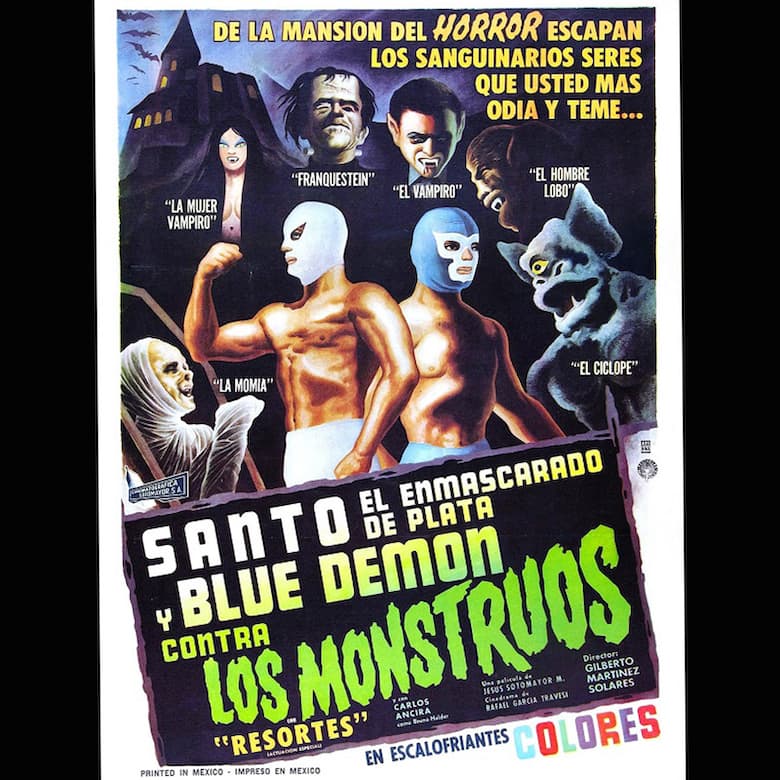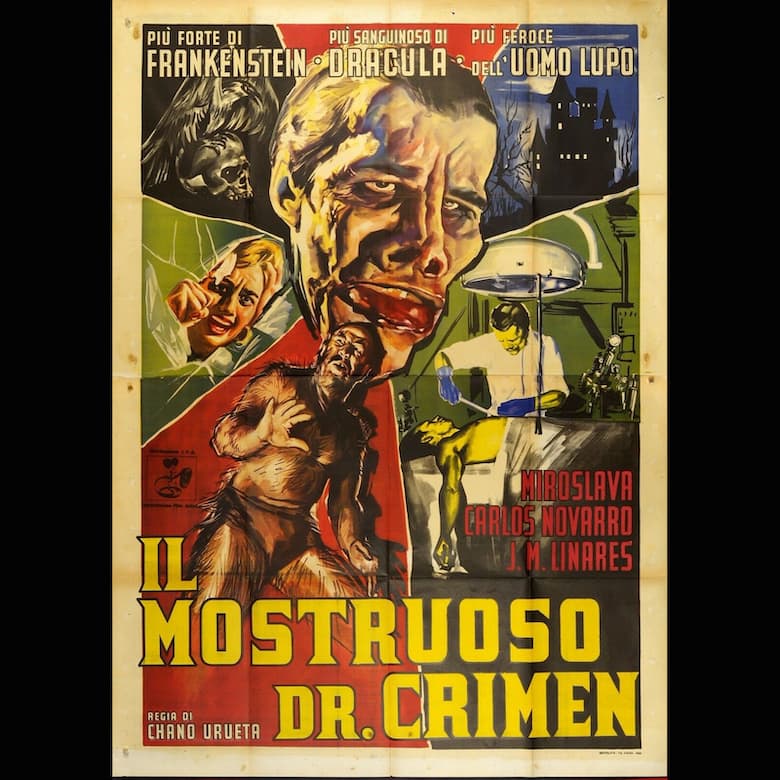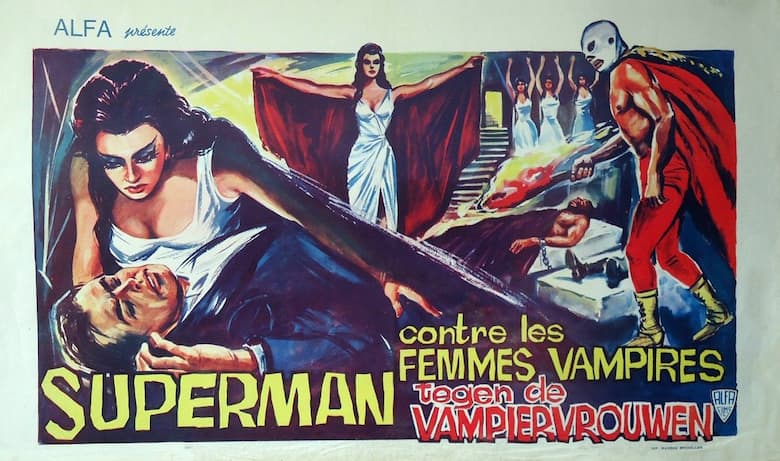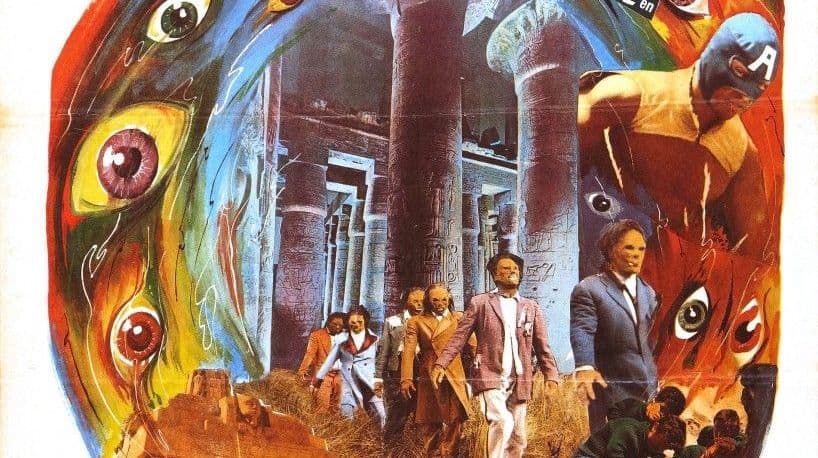The roots of lucha libre are believed to have begun during the Second Franco-Mexican war. A free-style form of Grego-Roman wrestling was developed and became regionally popular in the 1900s. The Empresa Mexicana de Lucha Libre was founded in 1933, giving the sport a national foothold. It is the oldest professional wrestling promotion in existence.
The beloved sporting event became a national obsession in the 1950s following regular television broadcasts, inspiring devoted followings and subcultures that immortalized wrestlers in comic books and cinema. These luchador movies would transform the high-flying athletes into crime fighting folk heroes, ripening lucha libre into an undisputed part of Mexico’s cultural heritage.
Behind The Mask of the Luchador Movie Trend
The most well-known luchador star of the ring and the screen is El Santo. Rodolfo Guzmán Huerta’s professional wrestling career would span 5 decades, using the name “El Santo” for the first time in 1942. Initially reluctant to appear on film at first Huerta would relent 1958 to great commercial success. Starring in 52 films, Santo would become a Mexican symbol of justice.
Legendary wrestling rival of Santo is Alejandro Muñoz Moreno. Professionally known as The Blue Demon since 1948, Moreno began his career in the ring as a heel. In 1952, Santo defeated and unmasked his tag team partner, prompting Blue Demon to become a good guy. Producer of luchador movies, Enrique Vergara, sought to bring another wrestler into pictures. After discovering Moreno, Blue Demon would go on to star in 25 action and fantasy films. Of those, Santo would co-star in nine of them.

In 1966, Vergara would then discover Aarón Rodríguez Arellano, an international heavyweight luchador. Arellano was offered the role of Mil Mascaras, the first character created specifically for the movies. Mil Mascaras would star in 20 luchador movies, in which he’d make several costume changeups as the man of a million masks.
Not to be outdone by the dudes in the ring, Las Luchadoras were a rotating troop of wrestling ladies. Appearing in 6 films, the gals would face off with Satanists, mad scientists, and sometimes each other in the ring. Perhaps the most recognizable actress of the Las Luchadoras films is Lorena Velázquez. Iconic femme fatale of Mexican cinema, her roles in luchador movies evolved from side parts in Santo flicks to leading villainesses. Velázquez would also appear as Gloria/Loreta Venus in 3 different wrestling movies.
Mexican Horror
Mexico’s horror genre got its proper start in the 30s with the films of Juan Bustillo. But it wasn’t until 1953 that it would outshine the dramas and westerns in most of the country’s movie houses. The success of Chano Urueta’s El Monstruo Resucitado had audiences begging for more, officially ringing in the golden age of Mexican cinema. The movies would echo the iconography of Universal and Hammer horror. They had gothically stylized scenes with expressionist cinematography, injecting the local lore like The Aztec Mummy and La Llorona.

With television of the ‘50s dominated by the popularity of lucha libre, big screen adaptations were a natural transition. The flashy pageantry of costumed heroes in action would blend perfectly with fantasy story lines. Hardboiled detective plots and crime rings of luchador movies began to take on more supernatural and science fiction elements. Proving to be enormously popular, they remained a staple of Mexico’s commercial cinema until the mid-1970s.
American producer K. Gordon Murray launched Mexican horror to a wider audience through his distribution of foreign films. The exploitation maven would rewrite and overdub his movies for English-speaking audiences at Soundlab Inc. While his catalog contained many adult and children’s films, over half of the titles were horror from Mexico. Murray was particularly fond of luchador movies and contributed to the success of 2 of the most popular, Santo VS The Vampire Women and The Wrestling Women VS The Aztec Mummy.
Luchador Films of Note
There is no shortage of mad scientists and reanimated corpses in luchador movies. Santo Vs. Los Zombies (1962) is considered the first real Santo movie where he is established as a crime fighter. A crazed doctor reanimates dead murderers and thieves to do his bidding. Only Santo can stop these minions from robbing jewelry stores and setting fires to orphanages.
Las Luchadoras Vs. El Médico Asesino (1963) offers up an evil surgeon experimenting with brain transplants and needing more specimens. Kidnapping women and creating a mindless lady wrestler that Gloria Venus and Golden Rubi must defeat in the ring. Director Rene Cardona would reimagine his own film twice in 1969. Las Luchadoras Vs. El Robot Asesino would have an identical plot and borrow aesthetic from the British television series, The Avengers. Again, the same year would follow the surreal Night of The Bloody Apes. A similar movie with a devil-themed luchadora and featuring footage of open-heart surgery.
Alien invasion was a common trope among luchador sci-fi films. The campiest of which was Santo Vs. La Invasion De Los Marcianos (1967). All of Mexico’s TV transmissions are interrupted by 3-eyed aliens in gold lamé costumes. Sick of humans’ nuclear weapons, they demand peace and brotherhood through fear and destruction. Blue Demon would get a few alien invasion films of his own. In true B-movie style, Aranas Infernales (1968) brings spiders from space, seeking brains to feed their dying queen. Naturally, mankind’s fate is settled in the ring, complete with a were-spider transformation and hand puppets.
While several luchador movies would feature Count Dracula going toe to toe with masked fighters, the vampire woman trope proved much more successful in the genre. Santo Vs. Las Mujeres Vampiro (1962) give the audience a clan of vampire women seeking a successor for Queen Zorina. But the clan needs human blood for a proper glow up and decided to avenge an ancestor while they’re at it. Mil Mascaras’ lady vampire movie, Las Vampiras (1969), finds him running afoul of a clan following a plane crash. As bodies pile up, he must defeat the vampire women as they fight amongst themselves with interpretive dance and dueling fire poi.

Mummies and werewolves were incredibly popular in luchador movies, showing off their direct inspiration from Universal horror films. Along with the monster mashups that double billed multiple heroes like Santo y Blue Demon Vs. Dracula y El Hombre Lobo (1973). The films that pitted masked men against different descendants of Dr. Frankenstein are representations of Hammer Film influence, such as Santo Vs. La Hija De Frankenstein (1972) and Santo y Blue Demon Vs. Dr. Frankenstein (1974).
Lastly, the homage to gothic horror is best represented in La Sombra Del Murcielago (1968), a luchador version of Phantom Of The Opera where a disfigured wrestler kidnaps a beautiful singer and Blue Demon must come to the rescue.
From The Ring To The Screen
Though low-budget and mass-produced, luchador movies falling into the horror genre have maintained their popularity into modern times. For lovers of exploitation, these films continue on as throwbacks or updated gritty formats. Mil Mascaras concluded a film trilogy in 2015 with Aztec Revenge. In 2006 Wrestlemaniac honored its raunchy roots with Rey Misterio Sr. as an insane luchador slasher.
— FOUNDATIONS OF HORROR —
Further explore these subgenres & tropes. more>>
#Action horror | #Mad Scientist | #Vampire Horror

Just as lucha libre is the direct inspiration for the flair and showmanship of WWE, luchador movies have influenced today’s athletes. Duane Johnson and Dave Bautista are now A-listers and casting pro-wrestlers in horror films is more commonplace than ever. Horror and professional wrestling entertain through anxiety and suspense. The union of both within cinema is a sensational delight with a rich heritage.
Further Reading
The Mexican Masked Wrestler and Monster Filmography by Robert Michael “Bobb” Cotter
The films of Chano Urueta
The films of Rene Cardona
Life and career of K. Gordon Murray
Last Updated on January 14, 2022.

